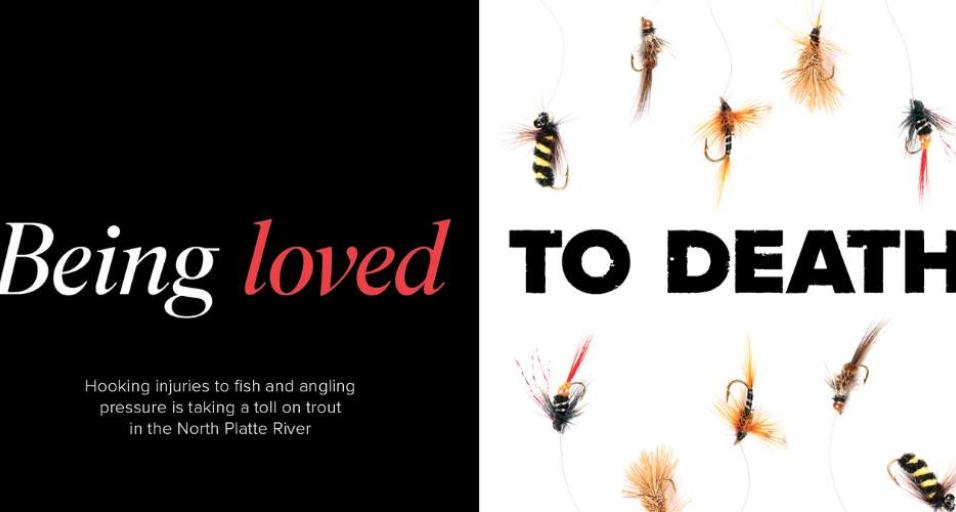In popular fishing locales, like along the North Platte River in the Casper Region, anglers can be seen catch-and-release fishing regularly. It’s home to some of the best trout fishing in the country, which includes stretches called the Miracle Mile, Cardwell and Gray Reef. People from near and far flock to this area, and angling pressure is currently double or triple what it’s historically been.
Although Wyoming Game and Fish Department regulations allow for modest harvest of fish on this stretch of the river, creel interviews over the last decade suggest few anglers do. Most release fish so they can be caught another day.
There lies the problem — more anglers going after a large amount of fish and releasing them. The results have shown more hooking injuries to fish that could be detrimental to the fish population.
“It’s being loved to death,” said Jeff Glaid, Game and Fish fisheries biologist in the Casper Region.
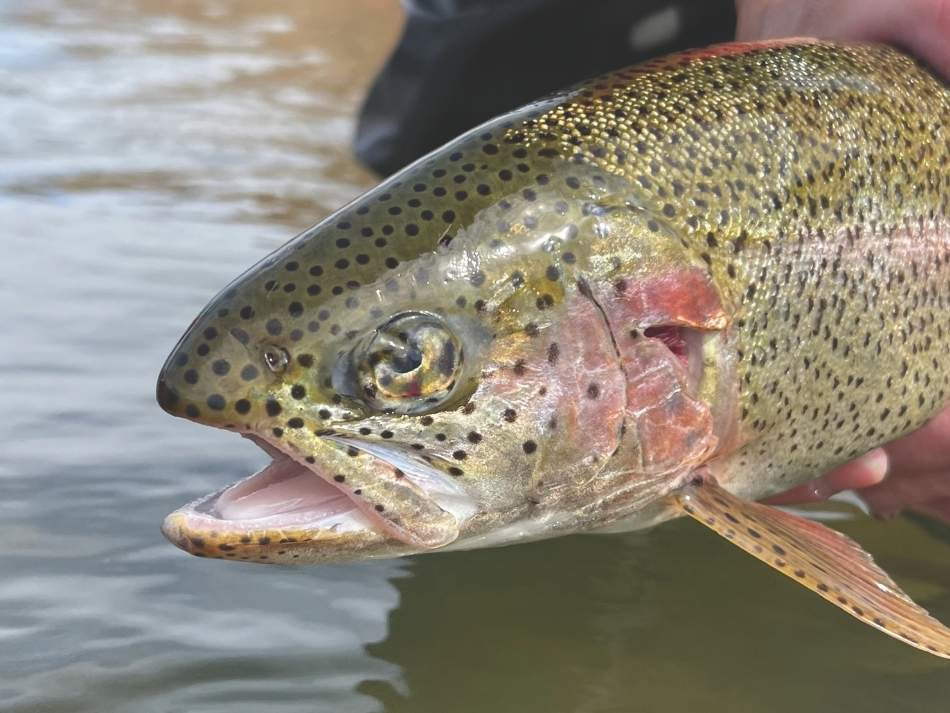
Rainbow trout with an injury rating of 3, the second-most severe on a scale developed by Wyoming Game and Fish Department Fisheries Biologist Jeff Glaid. (WGFD photo)
Glaid created a scale to better measure the severity of hooking injuries to trout on this stretch of the North Platte River — the first-of-its-kind — to better understand the scope of this issue and possibly come up with some solutions.
SCALE SPECIFICS
Glaid lived at the Miracle Mile for two years and has fished that stretch of the North Platte River hundreds of times. Matt Hahn, Glaid’s boss and Casper Region fisheries supervisor, also knows the area well.
During sampling of trout at the Miracle Mile in 2018, Glaid noticed while measuring fish that many had injuries to the mouth and eyes that looked to be from fishing tackle — especially larger fish. Crews kept track of these injuries with a “yes” or “no” format in terms of whether fish were injured or not. Glaid said 54 percent of the fish sampled that year were injured to some degree.
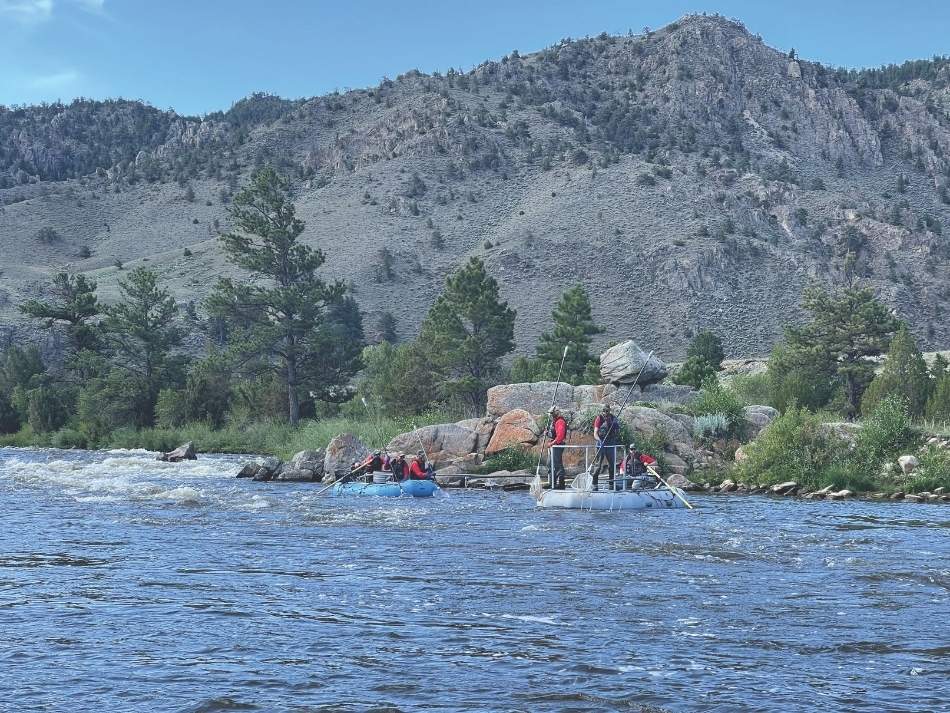
Game and Fish fisheries management personnel use raft-based electrofishing to monitor trout populations in shallow, high-gradient systems like the Miracle Mile stretch of the North Platte River in the Casper Region. (Photo by Jeff Glaid/WGFD)
The next year, Game and Fish sought similar information at other well-known stretches of the North Platte. Glaid said the Gray Reef and Fremont Canyon sections of the river were just as bad or worse in terms of injured fish compared to the Miracle Mile. Glaid also noticed most of the fish with hooking injuries from Gray Reef were thinner or less healthy than fish without injuries.
Hahn tasked Glaid to come up with a way to record these injuries and rank the severity.
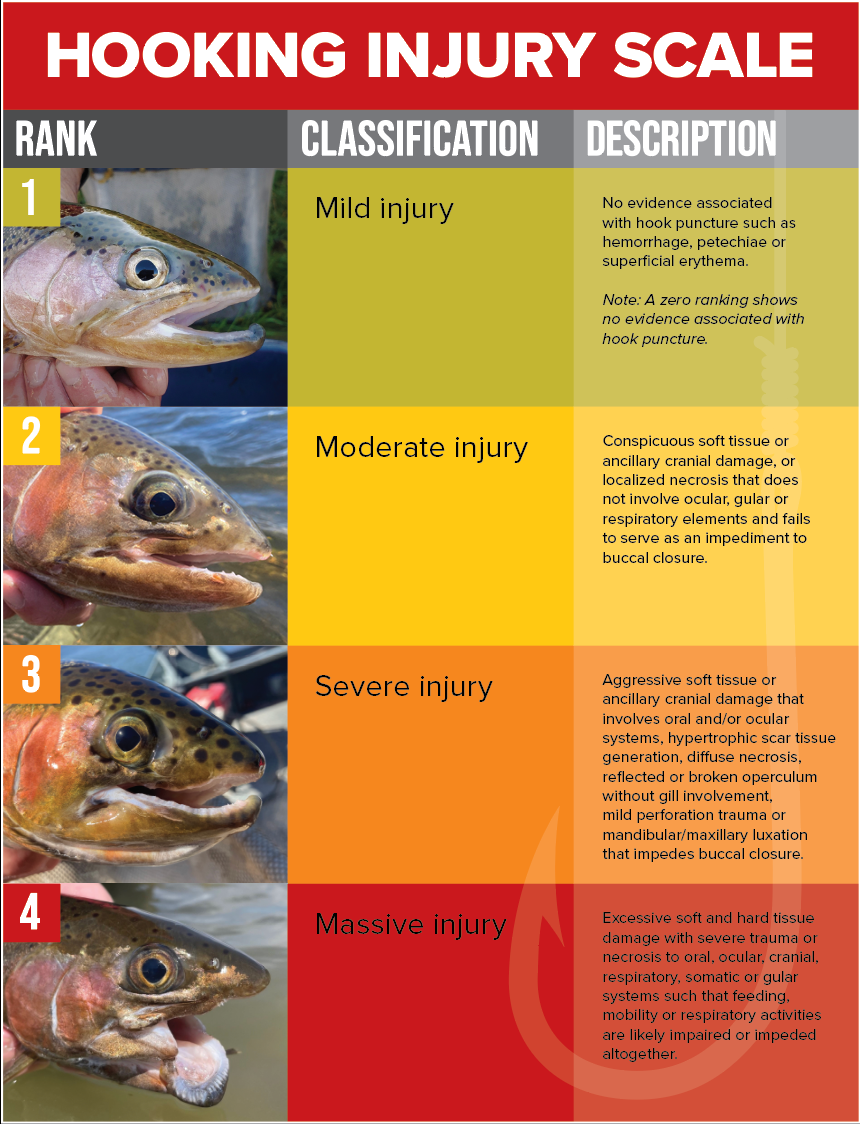
“Jeff came up with the index on his own,” Hahn said. “I lined out that I would like to see a more quantitative injury ranking than simple presence/absence. He did all the heavy lifting.”
Glaid said it took him a few weeks to come up with something. He looked at what other states did, but found nothing related to quantifying sub-lethal angling impacts. He turned to his time working with birds in a veterinary role, and also got feedback from his wife, who is a medical laboratory scientist. Glaid set up criteria to rank the severity of hooking injuries for fish, similar to some wound classifications for humans.
“It was a combination of rational thought and basing it off of preestablished wound rankings in the medical field for people,” Glaid said.
The scale consists of ranks, classifications and descriptions for fish hook injuries. It was put to use for the first time from the summer of 2020-fall 2021 where more than 6,500 trout from 14 locations were sampled along the North Platte.
GLAID SCALE USED THROUGHOUT STATE
Similar hook injury studies of fish in Wyoming waters have been conducted by the Wyoming Game and Fish Department using the scale and ranking system developed by Game and Fish Casper Fisheries Biologist Jeff Glaid.
Seven of the eight Game and Fish regions used Glaid’s scale over the last few years at 23 locations, and nearly 8,100 fish were evaluated — not including the North Platte River area in the Casper Region.
One was in the Sheridan Region in 2022 on the North Tongue River, where crews sampled six sections of the river by electrofishing from Burgess Road to the headwaters of the river. A total of 239 trout longer than 6 inches were sampled and 36.4 percent had evidence of a hooking injury. Specifically, 19.2 percent had mild injuries, 7.5 percent had moderate, 8.8 percent had severe and 0.84 percent had massive injuries. When figured into the average population estimate among all six stations, approximately 180 fish per mile had some level of hooking injury — 48 of which included severe and massive injuries.
A higher proportion of fish with severe or massive injuries occurred within the catch-and-release section of Bull Creek upstream to the headwaters. The catch-and-release section was extended downstream to Burgess Road in 2022.
Andrew Nikirk, Game and Fish fisheries biologist in the Sheridan Region, said it’s plausible anglers harvested badly injured fish prior to the regulation extension below Bull Creek, while anglers are forced to release fish above Bull Creek.
Nikirk also said he was impressed with Glaid’s grading system to measure the severity of hooking injuries to fish.
“It was great, and Jeff did a great job talking and teaching each of our crew what to look for before the assessment,” he said.
There is a subjective aspect of Glaid’s scale. Different people might have a different idea of what each level of injury should look like. However, the more it is used, the more time aspects such as this can become more consistent.
MORE ON THE SAMPLING
The 14 locations consisted of 86.4 miles of tailwater habitat in the North Platte between Kortes Reservoir and the confluence of Deer Creek in the town of Glenrock. The Miracle Mile section was the longest of the sections at 14.7 miles.
“The river is a continuum because it is all connected, so you have to figure out where the problem is focused and where things start to change,” Glaid said. “We wanted more frequent sampling along the gradient, so that was the idea to do these different sites.”
Electrofishing from jet boats or rafts was used to sample fish. Glaid said the 6,500 fish sampled, all of which were greater than 8 inches long, was a “robust” number, which consisted of rainbow, cutthroat and brown trout. More than 70 percent of the fish sampled at the Miracle Mile had some sort of hooking scar.
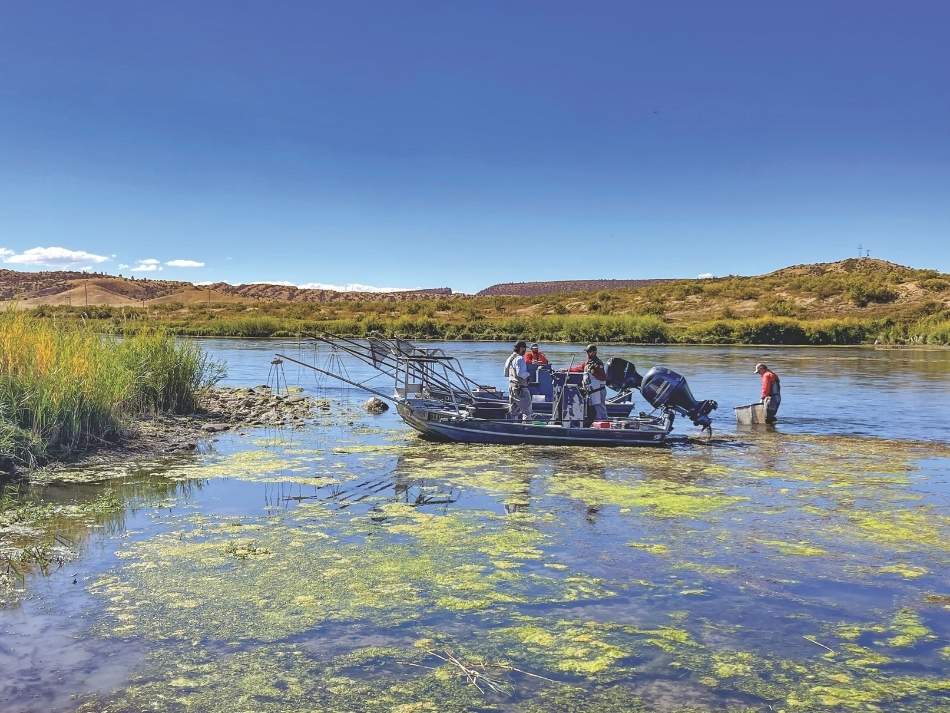
Jet boat electrofishing is used to sample lower-elevation sections of the North Platte River such as Gray Reef. Fisheries biologists use measurement and daily capture data to calculate estimates of population abundance, biomass and injury prevalence. (Photo by Jeff Glaid/WGFD)
Game and Fish wanted to see how hooking injuries affected the fish’s ability to see, breathe and eat. The higher the ranking on the scale, the more it impeded these fish from doing any or all of these things.
“This gives us an accurate look at injury prevalence and severity,” Hahn said. “The severity aspect is backed up by our observations of fish condition where more severely injured fish display significantly lower body condition, proving the index is effective at showing the severity of an injury and underscoring that there is a physiological consequence of higher injury rankings — it is not merely cosmetic.”
REDUCED REPRODUCTION
There are published studies that show fish with decreased fat reserves also have decreased fecundity — number of eggs by females, milt from males and eggs maturing into fish. Those studies also found eggs from fish in poorer condition are more susceptible to low hatch rates and fungal infections before they hatch.
So, if hooking injuries are causing sexually mature trout to be thinner and less healthy, could that have an impact on the population on these stretches of the North Platte?
Glaid said there is no way to empirically tie these two things together because Game and Fish does not have the ability to do lab trials or track individually injured fish to their spawning beds, test the overall quality of their offspring or gather data on hatch rates of eggs.
“As you put all of these puzzle pieces together, that has been illuminating in terms of how it correlates,” Glaid said. “Even in years where we have had all the good conditions historically that have yielded high populations of fish — good water flows, flushing flows that clean gravel and no high or low fluctuations in water flows — we’re not seeing evidence of increased spawning success.
“Our population has become somewhat stagnant or an aging population. We have a stable number of individuals that get large, but we do not have enough recruitment, or individuals born into the population, to result in population increases.”
In other words, hooking injuries to fish could be having an impact on trout populations on the North Platte River trout around Casper.
Another potential layer to add to this: Game and Fish has evaluated the number of anglers and the timing of those anglers on these stretches of the North Platte. The majority of anglers fish April-June.
“That time period coincides exactly with the peak of spawning for these fish,” Glaid said. “Research shows the more you disturb individual fish while they’re trying to spawn, the less likely they will be successful at spawning.”
THROW THEM BACK
The 14 sections of the North Platte sampled for hooking injuries allow for the modest harvest of fish according to Game and Fish regulations, and many require anglers to use artificial flies and lures only.
There are no catch-and-release regulations for this stretch of river, but that’s what most anglers do.
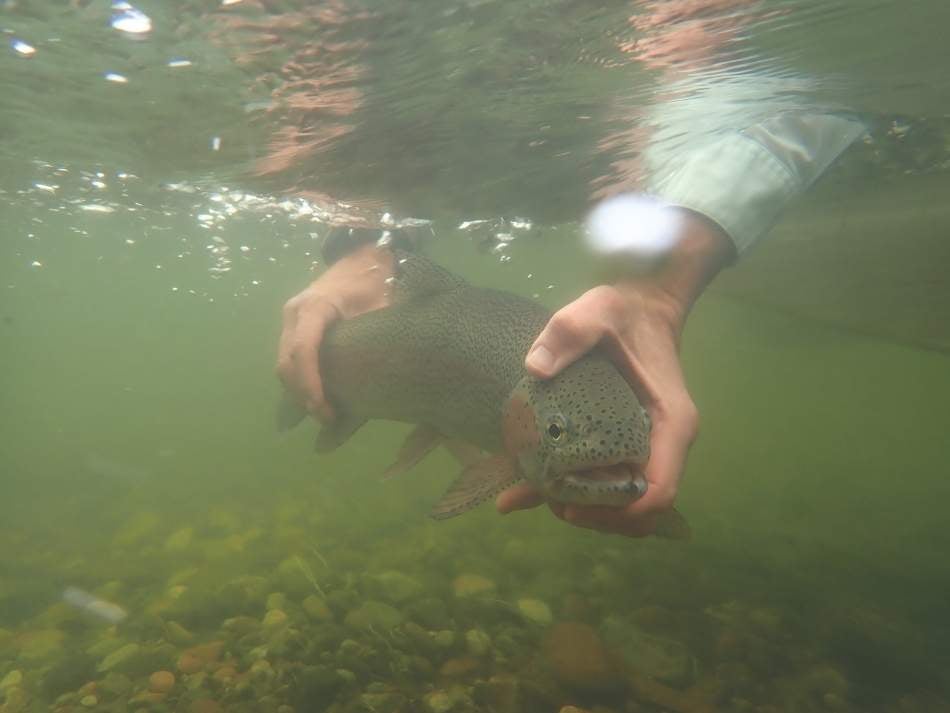
Most anglers who visit the Miracle Mile and Gray Reef catch-and-release trout resulting in many fish with hooking injuries being reintroduced instead of harvested. (Photo by Jack Ballard)
“We’ve done more than 2,000 interviews of anglers on the river the last four years, and we’ve had zero cases of declared harvest in the Grey Reef or Miracle Mile sections,” Glaid said. “We go out on weekends, weekdays and do dozens of interviews per day. We know that the number is more than zero, but we also know the number is very low.”
In a nutshell, this part of the North Platte has a lot of fish, a lot of anglers and a lot of fish that are released by anglers with hooking injuries.
NEXT STEPS
Glaid said the public asks him and his coworkers frequently about limiting the number of anglers on the river.
“We can shut places down and do closures, but when we do closures it's an all-or-nothing thing,” he said. “There’s no caveat that says we’re only going to close it to certain individuals. If you close it down to one, you have to close it down to all for a period of time. That isn’t desirable and would go against wanting to have a viable, recreational fishery.”
Game and Fish received public input, and the Wyoming Game and Fish Commission passed new regulations in July that will mandate single-point, barbless hooks and prohibit peg attractors on some stretches of the North Platte with the hope to reduce hooking injuries to trout. Those regulations will go into effect in 2026.
However, it will take some time to see if those regulations reduce hooking injuries to fish.
“We will have to wait 4-5 years and redo this entire hooking injury study at the same places and the same way,” Glaid said. “The maximum life span of the fish in the river is 4-5 years. That would mean by 2031, any fish that would have been available to be caught by barbed hooks would have aged out of the population. We’d be dealing only with fish that grew up with a barbless regulation, and see if there are differences in the quality of individual fish.”
— Robert Gagliardi is the associate editor of Wyoming Wildlife.

